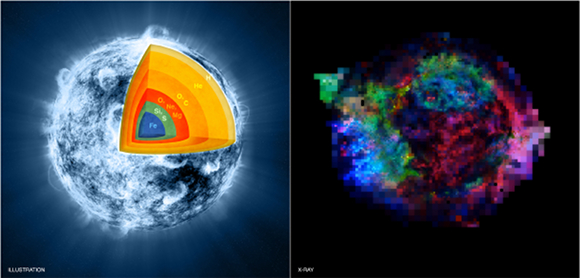This article is more than 1 year old
Star's guts turned INSIDE OUT in supernova mega-blast
Young Cas A star spews stellar innards
Pics An X-ray study of Cassiopeia A, one of the youngest exploded stars in our galaxy, has found that it not only blew up, but also ripped its insides out in the process.

Before and after the Cas A supernova. Left: NASA/CXC/M Weiss; Right: NASA/CXC/GSFC/U.Hwang & J Laming Credit: NASA
Cas A, which is about 11,000 light years away, was once a star with an iron core surrounded first by sulphur and silicon and then by magnesium, neon and oxygen.
Then it went supernova and, as NASA's Chandra X-ray Observatory has discovered, 300 years later, the magnesium, neon, sulphur and silicon are located around the centre of the still-expanding debris while the iron is to be found on the outer edges of the remnant.
Neither Chandra nor the Spitzer Space Telescope, which uses infrared, can find any traces of iron in the centre, where it was once formed.
Boffins used a million seconds of observing time (over 11 days) to build up the most detailed study ever made of X-ray-emitting debris in the remnants of a massive star's explosion.
Using all the observations, the space boffins reckon that the debris has a mass more than three times of our Sun, containing 0.13 times the mass of our star in just iron, 0.03 times in sulphur and 0.01 times in magnesium.
The astronomers also verified that the star-wreckage had clumps of almost pure iron, which must have been made by nuclear reactions at the centre of the star before the supernova. The Compton Gamma Ray Observatory, BeppoSAX and the International Gamma-Ray Astrophysics Laboratory had already spotted the signature of this kind of nuclear reaction in Cas A.
The full study of Chandra's X-ray observations was published in The Astrophysical Journal. ®
